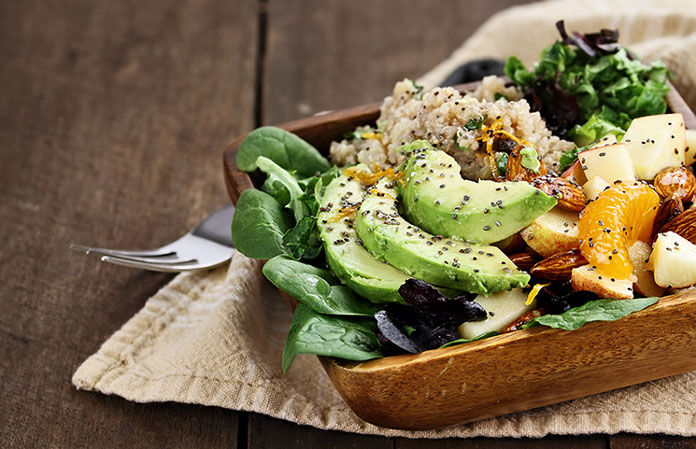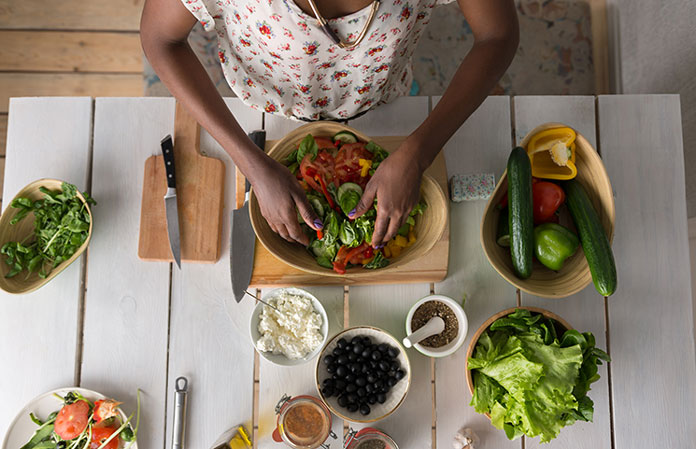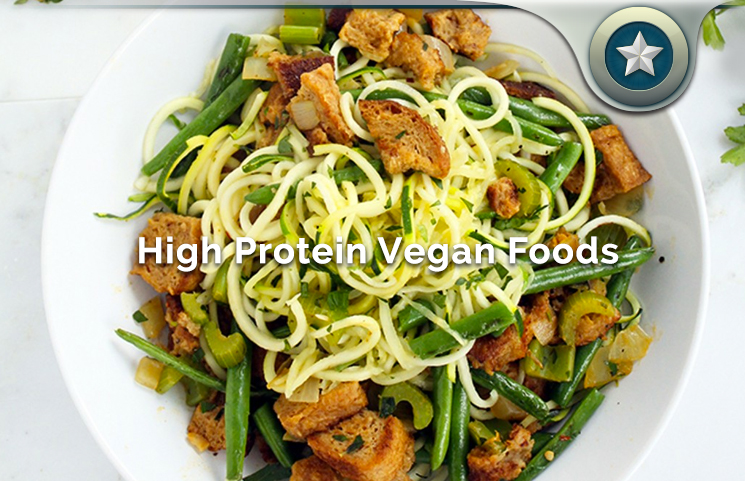Being vegan is a lifestyle that many people all around the world are pursuing. Being a vegan means that one does not eat meat, meat products, or any other products that a animal can produce (eggs, milk, meat, honey, etc).
Being vegan comes with many benefits, and can even aid in keeping your body healthy. Lower cholesterol, lower blood pressure, weight loss, healthier skin, more energy, and increasing your life span are many of the benefits of veganism.
But, along with positive things also come negative ones as well. Meat and other animal products contain very high amounts of protein, which most vegans may be missing out on.
Top 27 Sources Of High Protein Vegan Foods
Here is a list of foods that are vegan and can help pick up the slack in the protein area:
1. Soybeans And Soy Products
Soybeans (soya beans) are a type of legume. They are native to Eastern Asia, while today they also grow in North and South America and Asia. In Asia, people would mainly eat the soybeans whole. Today soybeans can also be seen in many products, such as soy milk, soy flour, soybean oil, soy protein, tofu, and even soy sauce. These are all commonly seen in almost every grocery store among hundreds of other products that contain soybeans.
Soy contains phytonutrients and antioxidants that have been liked to hundreds of benefits. Protein is found in all types of soybeans and soy products, because of the two main types of protein that make up around 80% of the total protein content (conglycinin and glycinin). But be aware that these proteins have been known to trigger allergic reactions in some people.
2. Chia Seeds
Chia seeds are one of the healthiest seeds on the Earth, as they are loaded with so many important benefits that can help improve ones brain and body functions. They are high in quality protein (14% of the weight actually), which most plant foods don't have a lot of. They also contain large amounts of amino acids, which our bodies will later turn into protein.

3. Quinoa
Quinoa is a commonly chosen food for vegans, as it is very high in protein and contains all nine of the essential amino acids (unlike most plant foods). It's also very popular as it is gluten-free.
This can be eaten by adding raw quinoa to boiling water, making it a fluffy, nutty, wonderful source of protein.
4. Hemp Seed
Hemp seeds are the seeds of the cannabis sativa, commonly known as marijuana or cannabis. Although they have THC (very small traces), these hemp seeds don't give the “high effect” as marijuana does. This seed gives similar amounts of protein as meat, such as cattle and lamb.
These are also like quinoa, as they give all the essential amino acids needed by the body to make protein. Hemp is easily digested by the body, making for an overall healthy digestive tract. Eating these seeds is easy as they can be consumed roasted, raw, or cooked with any dish.
5. Amaranth
Amaranth is a grain-like seed that is very rich in protein and is bio-available. Discovered and first used by the Aztecs, this gluten-free grain is over 7,000 years old. It is currently popular in Africa, China, Peru, South and North America, and even Russia. This grain has over nine grams of protein in just one cooked cup.
Amaranth can be eaten by boiling it with water, pouring it onto fruits, adding it to soups, or even adding it to a smoothie.
6. Ezekiel Bread
Ezekiel bread is commonly known as a healthier alternative to eating traditional white bread. You also may have heard this tremendously old bread mentioned in the Bible, as the Israelites would have to eat and prepare this while in exile for over 350 days. This bread can be home-made or bought at a local grocery store. It can be topped with peanut butter, Nutella, or jams.
7. Hummus
Hummus is made from chick peas ground up with added spices, normally ranging from garlic powder to peppers. It's very popular in the Middle Eastern region, but can now be found anywhere around the world.
Not only is it very high in protein, it is also high in fiber, which will help the body get rid of waste faster than normal. Although it doesn't have all nine essential amino acids, it has one very important one called mthionine.
This is the active compound that makes hummus have the high protein count. Hummus is usually served as a dip, but can be used as a spread for bread, bananas, or even crackers.
8. Spinach
Spinach is a leaf commonly found in a tossed salad and is commonly featured in old PopEye episodes to encourage children to try it. Adding great flavor to anything it is put on, there are three grams of protein in half a cup of spinach.
It is not only good for the high amount of protein, but it is also good for the skin, eyes, and brain health. It can be consumed by boiling it, adding it to a side dish, throwing it in a salad, or even eating it raw.
9. Pumpkin Seeds
Pumpkin seeds are seen more frequently around Halloween time, as some people will bake the seeds, adding cinnamon or other spices and enjoying them as a healthy snack. One ounce of pumpkin seeds has 9.35 grams of protein, doubling the amount of protein found in ground beef. They can be eaten as a snack, added to a salad, or even roasted.
10. Cauliflower
Cauliflower has a list of health benefits, but the most important benefit would be the protein levels it contains. Commonly grown and popular in China and India, this vegetable isn't nearly as popular in the United States.
Although cauliflower's taste isn't the most desirable thing, it can be seasoned and cooked many different ways. Raw cauliflower is known to taste the worse, which is why steaming or boiling it is much more popular.
11. Peanuts And/Or Peanut Butter
Peanuts are very popular in the United States, as basically everyone has once tried them in some sort or fashion. Many don’t know about the protein count this nut has: 6.71 grams per 28 individual peanuts. Peanuts can be used to make peanut butter, which is usually eaten on bread or crackers, though some people enjoy eating it straight from the container.
Peanuts can be boiled (very popular where they are commonly grown in Georgia), eaten raw, salted, or used as a spread.
12. Oats
Oats, also known as oatmeal, have a long list of benefits to the human body. They have 6.08 grams of protein per one cup, making it a great way to get protein into the daily diet.
Usually oatmeal is eaten as a breakfast food, because not only does it have high protein levels, it also has high fiber levels as well. Oats have been used for improving the health of the skin, eyes, scalp, and even the heart. They can be consumed as oatmeal, put in protein bars, or used in shakes and smoothies.
13. Mung Bean
Mung beans are a great source of protein and are also low in calories. They can lower blood cholesterol levels, strengthen nails, and they even contain anti-aging components.
This bean can be eaten alone, added to a stir-fry, or even added to a smoothie. They also have been used to make face masks, as they contain phytoestrogens (which stimulates the collagen found in skin).
14. Asparagus
Asparagus is known for making one's urine smell bad, but the positive benefits sure do out-weigh the negatives. Asparagus is a green, stick-like vegetable that contains 3.08 grams of protein for about every eight spears. It can be grilled, pan fried, or cooked alone as a side dish.
Along with the large amount of protein for such little size, it also contains many vitamins, such as vitamins K, A, and C.
15. Brussel Sprouts
Brussel sprouts are one of the most hated vegetables known by kids for their reputation of smelling and tasting foul. However, they do have a tremendous amount of protein and potassium. Half of a cup contains two grams of protein, which is wonderful considering one doesn't have to eat much to gain benefits. They can be eaten raw, baked, fried, or seasoned.
16. Corn
Corn is a very popular grain that is widely eaten across the globe. Only half a cup of corn contains over two grams of protein. Corn was originally eaten on the cob, but over the years, it has progressed to many different eating options, such as popcorn, creamed corn, or shelled corn. Beware as this is a great source of protein, but can also be very fatty.
17. Black Beans
Black beans are one of the healthiest of all legumes and beans. At half a cup, these beans add eight grams of protein to one's diet. They are largely grown and produced in Brazil and India, but eaten all over the world.
These beans are also high in fiber, which is very important if one wants to live a healthy lifestyle. They can be eaten alone, added to a burrito, broken and mashed down (also known as re-fried beans in Mexican cultures), or eaten in soups or chilis.

18. Artichoke
Artichokes have high protein levels, but the heart of the artichoke contains all of the needed nutrients that one may want or need. Ancient Greeks used to use them as medicine, along with eating them as food.
It is low in calories and fat, full of vitamins (K, C, and B), and can help control the heart and blood flow better. It can be eaten raw, boiled, fried, grilled, or even added with other great sources of protein like beans and greens.
19. Tempeh
Tempeh is a form of soy that is very easy to digest, high in protein, and has loads of probiotics. Containing twelve grams of protein per cup, it is a healthier, fermented solution to soy.
20. Cashews
Cashews are often referred to as delicacies in the Caribbean as well as in Brazil. They are part of the nut family, and are one of the tastier ones. Cashews are known for the protein and fiber contained in the kidney shaped nut. A handful of these cashews have around four grams of protein. They are also wonderful for the heart, bones, and the development of blood vessels.
21. Tofu
Tofu is usually known as a boring, protein-full meat substitution for vegetarians. While some people may think that, tofu can be fixed up to add all kinds of flavor and can add different textures depending on what type of tofu one buys (it is available as soft or firm).
Tofu is a wonderful way to get protein into the body, because each cup contains over 10 grams.
22. Broccoli
Broccoli is a very popular veggie that is eaten throughout the world. Along with having four grams of protein in just one cup, it also only has 30 calories. Broccoli is loaded with fiber, vitamin C, and vitamin B. Usually having a bad rep in the younger generations, broccoli can be eaten many different ways.
Broccoli can be eaten raw, steamed, grilled, pan fried, baked, or added to a dish, making this a wonderful food for vegans everywhere. It also takes little time to prepare and cook.
23. Almonds
Almonds are a part of the nut family, and are similar to cashews. They are loaded with fiber, protein, and even healthy fats (which are great for the heart). They also have been linked to helping one lose weight as they are a filler, meaning eating this nut will make the stomach feel fuller. Ten almonds have 2.5 grams of protein, making this a delicious snack for those who are hunting for a protein filler.
24. Black Eyed Peas
Black eyed peas aren't just the popular band that you may think about when hearing the name. What most people don't know about black eyed peas is the large amounts of protein found in them, eight grams in just half of a cup.
They also have good amounts of magnesium, iron, B vitamins, and potassium. These peas can be eaten alone, added to a soup or chili, or even added to a burrito.
25. Spirulina
Spirulina is usually looked at as a nasty algae, and most consider it to be non-edible. But, this greenish blue algae actually has many benefits, so adding it to one's diet would be very important, especially when one is struggling to eat healthy.
It has four grams of protein in just one tablespoon, along with 80% of one's daily intake of iron that is needed to live a healthy lifestyle. Spirulina can be added to smoothies, drank alone, or can even be used as a topper for other dishes and sides.
26. Tahini
Tahini is a delicious spread that can be used on anything. It has eight grams of protein in two tablespoons and also has large amounts of potassium, magnesium, B vitamins, and iron. Tahini is known as a filler, as it fools the stomach into thinking it is fuller than it is. It can be eaten on basically anything, as it adds a delicious nutty taste. It has 2.6 grams of protein in one tablespoon.
27. Nutritional Yeast
Nutritional yeast is a deactivated yeast with loads of wonderful benefits. In just one tablespoon, it has three grams of protein. It also has all the B vitamins, fiber, and the recommended daily value of folic acid, which is commonly added during processing.
Adding this yeast to foods isn't hard as it can be sprinkled onto popcorn, added to soups and pastas, or even to spice up some regular mac and cheese. This can be found in powder form all around the world, usually in grocery stores or local food marts.

Side Note Regarding High Protein Vegan Foods
Radically changing your diet or adding new foods to your diet should always be consulted with your doctor or a registered dietitian, especially when going from eating meat regularly to becoming a vegan or if you have food allergies.
Everyone's bodies are different and handle things differently than others, so always be aware when adding something new. The foods listed above are high in protein, but could lack in other areas.
High Protein Vegan Foods Final Words
Being a vegan is difficult in many ways because meat and other animal products contain things our bodies may need to function, but always remember there are always substitutes. Being vegan can be a difficult life choice, but it also has many rewards.









